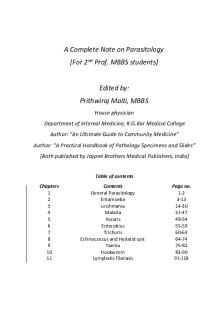A Note on Ecriture Feminine Theory PDF

| Title | A Note on Ecriture Feminine Theory |
|---|---|
| Author | Muhammad Numan |
| Pages | 2 |
| File Size | 47.8 KB |
| File Type | |
| Total Downloads | 536 |
| Total Views | 803 |
Summary
A Note on Ecriture Feminine Theory Muhammad Numan, PD-Lit-S19-592 PhD Scholar (English Literature), National University of Modern Languages, Islamabad. [email protected] Understanding Postmodern feminism which encompasses a combination of poststructuralism, postmodernism and French feminism, it ...
Description
A Note on Ecriture Feminine Theory Muhammad Numan, PD-Lit-S19-592 PhD Scholar (English Literature), National University of Modern Languages, Islamabad. [email protected]
Understanding Postmodern feminism which encompasses a combination of poststructuralism, postmodernism and French feminism, it is important to understand Ecriture feminism as it destabilizes the patriarchal norms being practiced in a society in general and promoting gender inequality in particular. The term ‘Ecriture feminism’ means ‘feminine writing’ is coined by Helen Cixous in 1976 in her essay “The Laugh of the Medusa”. It keeps its significant impact on foregrounding French feminism in practice by highlighting the significance of language and narration and determining the position of women in a society. Further, while understanding language, philosophy, psychoanalysis and social practices in a text, it approaches deconstructive approach by focusing on language and production of meaning within a text. Ecriture feminists argues that language has been a male realm which represents a word from male point of view. Contextualizing language and feminism into prose and women writing, they believe that female writers have promoted prose writing through their writings which was ‘an instrument fashioned for male purposes’. As in “Can the Subaltern Speak”, Gayatri Spivak says that women must act actively to overcome the patriarchal oppression in a society, similarly Helen challenges the phallocentric discourse by giving her view that women’s unconscious is different from men. First of all, women must isolate themselves from masculine ideologies within a text and society to nourish their own conscious. In doing so, women writers are supposed to create their own discourse under the title of ‘feminine discourse’ by challenging the phallocentric discourse on one hand, and expressing their own thoughts, desires and concepts on the other hand. The aim of employing Ecriture feminism on any discourse is to see a text and language in a psychological relationship of a culture and the depiction of female body and female difference. Further, it foregrounds the importance of language for psychic understanding of self through the belief that “humans come to understand their social roles and the job of the critic is to analyze the position of women as ‘other’ in a patriarchal symbolic text. In Virginia Woolf’s Three Guineas, the patriarchal image of women is highlighted in form of an economic commodity, and the commodity is being exchanged by men through marriage. Helen does not only provide an outcome of such patriarchal discourses by centralizing the issues of ‘loss of self and life of silence’ in her essay but also suggests by referring to Spivak that the empowerment to women must be given to change the position of women in social and textual discourse from ‘object’ to ‘subject’. In a nutshell, it can be said that bringing the self of women at the center of text by providing voice to an independent female having its own desire which is victimized inside the masculine suppressed women....
Similar Free PDFs

Note 10 - Feminist Theory
- 9 Pages

I. Architecture, ecriture...I
- 32 Pages

A Complete Note on Parasitology For 2nd
- 105 Pages

Case note outline on Mendoza
- 4 Pages

Brief NOTE ON Inhalation Anesthetics
- 13 Pages

Detail NOTE ON Local Anesthetics
- 5 Pages

Short NOTE ON Golgi Complex
- 3 Pages

TN2 - Note: A
- 16 Pages

CPE Essay - Note: A
- 2 Pages

Writing a case note
- 2 Pages

Python - Note: A
- 181 Pages
Popular Institutions
- Tinajero National High School - Annex
- Politeknik Caltex Riau
- Yokohama City University
- SGT University
- University of Al-Qadisiyah
- Divine Word College of Vigan
- Techniek College Rotterdam
- Universidade de Santiago
- Universiti Teknologi MARA Cawangan Johor Kampus Pasir Gudang
- Poltekkes Kemenkes Yogyakarta
- Baguio City National High School
- Colegio san marcos
- preparatoria uno
- Centro de Bachillerato Tecnológico Industrial y de Servicios No. 107
- Dalian Maritime University
- Quang Trung Secondary School
- Colegio Tecnológico en Informática
- Corporación Regional de Educación Superior
- Grupo CEDVA
- Dar Al Uloom University
- Centro de Estudios Preuniversitarios de la Universidad Nacional de Ingeniería
- 上智大学
- Aakash International School, Nuna Majara
- San Felipe Neri Catholic School
- Kang Chiao International School - New Taipei City
- Misamis Occidental National High School
- Institución Educativa Escuela Normal Juan Ladrilleros
- Kolehiyo ng Pantukan
- Batanes State College
- Instituto Continental
- Sekolah Menengah Kejuruan Kesehatan Kaltara (Tarakan)
- Colegio de La Inmaculada Concepcion - Cebu




